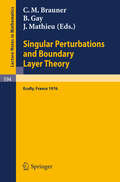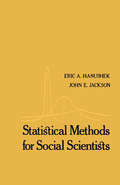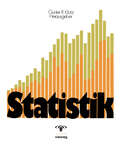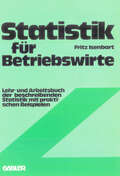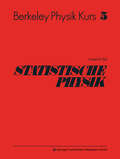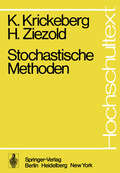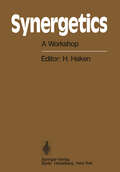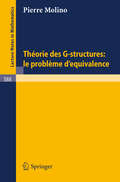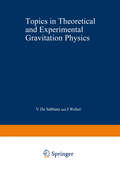- Table View
- List View
Singular Perturbations and Boundary Layer Theory: Proceedings of the Conference Held at the Ecole Centrale de Lyon, December 8-10, 1976 (Lecture Notes in Mathematics #594)
by C. M. Brauner B. Gay J. MathieuStabilität und Matrizen: Matrizenverfahren in der Stabilitätstheorie linearer dynamischer Systeme (Ingenieurwissenschaftliche Bibliothek Engineering Science Library)
by Peter Christian MüllerStability Theory by Liapunov’s Direct Method (Applied Mathematical Sciences #22)
by Nicolas Rouche P. Habets M. LaloyThis monograph is a collective work. The names appear ing on the front cover are those of the people who worked on every chapter. But the contributions of others were also very important: C. Risito for Chapters I, II and IV, K. Peiffer for III, IV, VI, IX R. J. Ballieu for I and IX, Dang Chau Phien for VI and IX, J. L. Corne for VII and VIII. The idea of writing this book originated in a seminar held at the University of Louvain during the academic year 1971-72. Two years later, a first draft was completed. However, it was unsatisfactory mainly because it was ex ce~sively abstract and lacked examples. It was then decided to write it again, taking advantage of -some remarks of the students to whom it had been partly addressed. The actual text is this second version. The subject matter is stability theory in the general setting of ordinary differential equations using what is known as Liapunov's direct or second method. We concentrate our efforts on this method, not because we underrate those which appear more powerful in some circumstances, but because it is important enough, along with its modern developments, to justify the writing of an up-to-date monograph. Also excellent books exist concerning the other methods, as for example R. Bellman [1953] and W. A. Coppel [1965].
Statistical Methods for Social Scientists
by Eric A Hanushek John E. JacksonThe aspects of this text which we believe are novel, at least in degree, include: an effort to motivate different sections with practical examples and an empirical orientation; an effort to intersperse several easily motivated examples throughout the book and to maintain some continuity in these examples; and the extensive use of Monte Carlo simulations to demonstrate particular aspects of the problems and estimators being considered. In terms of material being presented, the unique aspects include the first chapter which attempts to address the use of empirical methods in the social sciences, the seventh chapter which considers models with discrete dependent variables and unobserved variables. Clearly these last two topics in particular are quite advanced--more advanced than material that is currently available on the subject. These last two topics are also currently experiencing rapid development and are not adequately described in most other texts.
Statistics: A Biomedical Introduction (Wiley Series in Probability and Statistics #130)
by Byron Wm. Brown Jr. Myles HollanderThe Wiley Classics Library consists of selected books that have become recognized classics in their respective fields. With these new unabridged and inexpensive editions, Wiley hopes to extend the life of these important works by making them available to future generations of mathematicians and scientists. Currently available in the Series: T. W. Anderson The Statistical Analysis of Time Series T. S. Arthanari & Yadolah Dodge Mathematical Programming in Statistics Emil Artin Geometric Algebra Norman T. J. Bailey The Elements of Stochastic Processeswith Applications to the Natural Sciences Robert G. Bartle The Elements of Integration and Lebesgue Measure George E. P. Box & Norman R. Draper Evolutionary Operation: A Statistical Method for Process Improvement George E. P. Box & George C. Tiao Bayesian Inference in Statistical Analysis R. W. Carter Finite Groups of Lie Type: Conjugacy Classes and Complex Characters R. W. Carter Simple Groups of Lie Type William G. Cochran & Gertrude M. Cox Experimental Designs, Second Edition Richard Courant Differential and Integral Calculus, Volume I Richard Courant Differential and Integral Calculus, Volume II Richard Courant & D. Hilbert Methods of Mathematical Physics, Volume I Richard Courant & D. Hilbert Methods of Mathematical Physics, Volume II D. R. Cox Planning of Experiments Harold S. M. Coxeter Introduction to Geometry, Second Edition Charles W. Curtis & Irving Reiner Representation Theory of Finite Groups andAssociative Algebras Charles W. Curtis & Irving Reiner Methods of Representation Theory with Applications to Finite Groups and Orders, Volume I Charles W. Curtis & Irving Reiner Methods of Representation Theory with Applications to Finite Groups and Orders, Volume II Cuthbert Daniel & Fred S. Wood Fitting Equations to Data: Computer Analysis of Multifactor Data, Second Edition Bruno de Finetti Theory of Probability, Volume I Bruno de Finetti Theory of Probability, Volume II Morris H. DeGroot Optimal Statistical Decisions W. Edwards Deming Sample Design in Business Research Amos de Shalit & Herman Feshbach Theoretical Nuclear Physics, Volume 1—Nuclear Structure Harold F. Dodge & Harry G. Romig Sampling Inspection Tables: Single and Double Sampling J. L. Doob Stochastic Processes
Statistics of Random Processes I: General Theory (Stochastic Modelling and Applied Probability #5)
by R.S. Liptser A.N. ShiryaevA considerable number of problems in the statistics of random processes are formulated within the following scheme. On a certain probability space (Q, ff, P) a partially observable random process (lJ,~) = (lJ ~/), t :;::-: 0, is given with only the second component n ~ = (~/), t:;::-: 0, observed. At any time t it is required, based on ~h = g., ° s sst}, to estimate the unobservable state lJ/. This problem of estimating (in other words, the filtering problem) 0/ from ~h will be discussed in this book. It is well known that if M(lJ;) < 00, then the optimal mean square esti mate of lJ/ from ~h is the a posteriori mean m/ = M(lJ/1 ff~), where ff~ = CT{ w: ~., sst} is the CT-algebra generated by ~h. Therefore, the solution of the problem of optimal (in the mean square sense) filtering is reduced to finding the conditional (mathematical) expectation m/ = M(lJ/lffa. In principle, the conditional expectation M(lJ/lff;) can be computed by Bayes' formula. However, even in many rather simple cases, equations obtained by Bayes' formula are too cumbersome, and present difficulties in their practical application as well as in the investigation of the structure and properties of the solution.
Statistik: Beschreibende Statistik, Wahrscheinlichkeitsrechnung, Anwendungen
by Karl Bosch Gisela Engeln-Müllges Günter R. KlotzStatistik für Betriebswirte: Lehr- und Arbeitsbuch der beschreibenden Statistik mit praktischen Beispielen
by Fritz IsenbartStetige Faltungshalbgruppen von Wahrscheinlichkeitsmassen und erzeugende Distributionen (Lecture Notes in Mathematics #595)
by Wilfried HazodStochastic Models for Spike Trains of Single Neurons (Lecture Notes in Biomathematics #16)
by S.K. Srinivasan Gopalan Sampath1 Some basic neurophysiology 4 The neuron 1. 1 4 1. 1. 1 The axon 7 1. 1. 2 The synapse 9 12 1. 1. 3 The soma 1. 1. 4 The dendrites 13 13 1. 2 Types of neurons 2 Signals in the nervous system 14 2. 1 Action potentials as point events - point processes in the nervous system 15 18 2. 2 Spontaneous activi~ in neurons 3 Stochastic modelling of single neuron spike trains 19 3. 1 Characteristics of a neuron spike train 19 3. 2 The mathematical neuron 23 4 Superposition models 26 4. 1 superposition of renewal processes 26 4. 2 Superposition of stationary point processe- limiting behaviour 34 4. 2. 1 Palm functions 35 4. 2. 2 Asymptotic behaviour of n stationary point processes superposed 36 4. 3 Superposition models of neuron spike trains 37 4. 3. 1 Model 4. 1 39 4. 3. 2 Model 4. 2 - A superposition model with 40 two input channels 40 4. 3. 3 Model 4. 3 4. 4 Discussion 41 43 5 Deletion models 5. 1 Deletion models with 1nd~endent interaction of excitatory and inhibitory sequences 44 VI 5. 1. 1 Model 5. 1 The basic deletion model 45 5. 1. 2 Higher-order properties of the sequence of r-events 55 5. 1. 3 Extended version of Model 5. 1 - Model 60 5. 2 5. 2 Models with dependent interaction of excitatory and inhibitory sequences - MOdels 5. 3 and 5.
Stochastic Problems in Population Genetics (Lecture Notes in Biomathematics #17)
by T. MaruyamaThese are" notes based on courses in Theoretical Population Genetics given at the University of Texas at Houston during the winter quarter, 1974, and at the University of Wisconsin during the fall semester, 1976. These notes explore problems of population genetics and evolution involving stochastic processes. Biological models and various mathematical techniques are discussed. Special emphasis is given to the diffusion method and an attempt is made to emphasize the underlying unity of various problems based on the Kolmogorov backward equation. A particular effort was made to make the subject accessible to biology students who are not familiar with stochastic processes. The references are not exhaustive but were chosen to provide a starting point for the reader interested in pursuing the subject further. Acknowledgement I would like to use this opportunity to express my thanks to Drs. J. F. Crow, M. Nei and W. J. Schull for their hospitality during my stays at their universities. I am indebted to Dr. M. Kimura for his continuous encouragement. My thanks also go to the small but resolute groups of.students, visitors and colleagues whose enthusiasm was a great source of encouragement. I am especially obliged to Dr. Martin Curie-Cohen and Dr. Crow for reading a large part eX the manuscript and making many valuable comments. Special gratitude is expressed to Miss Sumiko Imamiya for her patience and endurance and for her efficient preparation of the manuscript.
Stochastic Processes: A Survey of the Mathematical Theory (Applied Mathematical Sciences #23)
by J. LampertiThis book is the result of lectures which I gave dur ing the academic year 1972-73 to third-year students a~ Aarhus University in Denmark. The purpose of the book, as of the lectures, is to survey some of the main themes in the modern theory of stochastic processes. In my previous book Probability: ! survey of the mathe matical theory I gave a short overview of "classical" proba bility mathematics, concentrating especially on sums of inde pendent random variables. I did not discuss specific appli cations of the theory; I did strive for a spirit friendly to application by coming to grips as fast as I could with the major problems and techniques and by avoiding too high levels of abstraction and completeness. At the same time, I tried to make the proofs both rigorous and motivated and to show how certain results have evolved rather than just presenting them in polished final form. The same remarks apply to this book, at least as a statement of intentions, and it can serve as a sequel to the earlier one continuing the story in the same style and spirit. The contents of the present book fall roughly into two parts. The first deals mostly with stationary processes, which provide the mathematics for describing phenomena in a steady state overall but subject to random fluctuations. Chapter 4 is the heart of this part.
Synergetics: A Workshop Proceedings of the International Workshop on Synergetics at Schloss Elmau, Bavaria, May 2–7, 1977 (Springer Series in Synergetics #2)
by Hermann HakenThis volume contains most of the invited papers presented at the International Work shop on Synergetics, Schloss E1mau, Bavaria, May 2 to.May 7, 1977. This workshop fol lowed an International Symposium on SynergetiGS at Schloss E1mau, 1972, and an Inter national SUl11l1erschoo1 at Erice, Sicily, 1974. Synergetics is a rather new field of interdisciplinary research which studies the self-organized behavior of systems leading to the formation of structures and func tionings. Indeed the whole universe seems to be organized, with pronounced structures starting from spiral galaxies down to living cells. Furthermore, very many of the most interesting phenomena occur in systems which are far from thermal equilibrium. Synergetics in its present form focusses its attention on those phenomena where dra matic changes occur on a macroscopic scale. Here indeed Synergetics was able to re veal profound analogies between systems in different disciplines ranging from physics to sociology. This volume contains contributions from various fields but the reader will easily discover their cOl11J1on goal. Not only in the natural sciences but also in ecology, sociology, and economy, man is confronted with the problems of complex sys tems. The principles and analogies unearthed by Synergetics will certainly be very he1pfu~ to cope with such difficult problems. I use this opportunity to thank the Vo1kswagenwerk Foundation for its support of the project Synergetics and in particular for sponsoring the International Workshop on Synergetics.
Theorie der Steinschen Räume (Grundlehren der mathematischen Wissenschaften #227)
by H. Grauert R. RemmertTheorie des G-Structures: Le Probleme d'Equivalence (Lecture Notes in Mathematics #588)
by P. MolinoTheory of Functional Differential Equations (Applied Mathematical Sciences #3)
by Jack K. HaleSince the publication of my lecture notes, Functional Differential Equations in the Applied Mathematical Sciences series, many new developments have occurred. As a consequence, it was decided not to make a few corrections and additions for a second edition of those notes, but to present a more compre hensive theory. The present work attempts to consolidate those elements of the theory which have stabilized and also to include recent directions of research. The following chapters were not discussed in my original notes. Chapter 1 is an elementary presentation of linear differential difference equations with constant coefficients of retarded and neutral type. Chapter 4 develops the recent theory of dissipative systems. Chapter 9 is a new chapter on perturbed systems. Chapter 11 is a new presentation incorporating recent results on the existence of periodic solutions of autonomous equations. Chapter 12 is devoted entirely to neutral equations. Chapter 13 gives an introduction to the global and generic theory. There is also an appendix on the location of the zeros of characteristic polynomials. The remainder of the material has been completely revised and updated with the most significant changes occurring in Chapter 3 on the properties of solutions, Chapter 5 on stability, and Chapter lOon behavior near a periodic orbit.
Theory of Hopf Algebras Attached to Group Schemes (Lecture Notes in Mathematics #614)
by H. YanagiharaThe Token Economy: A Review and Evaluation (The Plenum Behavior Therapy Series)
by Alan E. KazdinApplications of operant techniques in treatment and education have proliferated in recent years. Among the various techniques, the token economy has been particu larly popular. The token economy has been extended to many populations included in psychiatry, clinical psychology, education, and the mental health fields in general. Of course, merely because a technique is applied widely does not neces sarily argue for its efficacy. Yet, the token economy has been extensively re searched. The main purpose of this book is to review, elaborate, and evaluate critically research bearing on the token economy. The book examines several features of the token economy including the variables that contribute to its efficacy, the accomplishments, limitations, and potential weaknesses, and recent advances. Because the token economy literature is vast, the book encompasses programs in diverse treatment, rehabilitation, and educational settings across a wide range of populations and behaviors. Within the last few years, a small number of books on token economies have appeared. Each of these books describes a particular token economy in one treatment ,etting, details practical problems encountered, and provides suggestions for ad ministering the program. This focus is important but neglects the extensive scholarly research on token economies. The present book reviews research across diverse settings and clients. Actually, this focus is quite relevant for implementing token economies because the research reveals those aspects and treatment variations that contribute to or enhance client performance.
